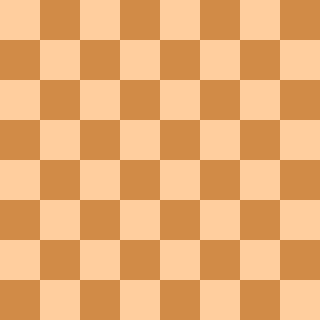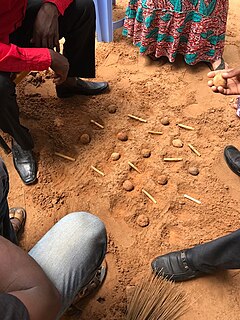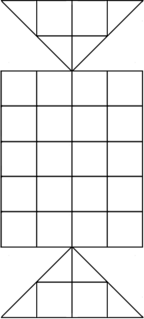Game Play and Rules
1. The board is empty in the beginning. The pieces are set beside the board.
2. Players decide what colors to play, and who starts first. Players alternate their turns.
3. Drop Phase: Players drop a piece onto a vacant point on the board that is not orthogonally adjacent to a piece of their own already on the board. A player may only drop one piece per turn. Players must continue to drop pieces until they can no longer do so according to the rule. If a player can no longer drop a piece, that player must pass their turn until the other player can no longer drop a piece also.
4. Move Phase: Both players are only allowed to move their pieces after both players can no longer continue to drop their pieces in the Drop Phase. This may mean that they still have a reserve of their pieces next to the board. It is uncertain, however, whether the remaining pieces in each player's reserve is ever dropped on the board later.
A piece moves one space orthogonally onto a vacant point on the board. Players who form a 3 in-a-row with their own pieces can remove any an opponent's piece from the board. The 3 in-a-row must strictly consist three pieces (no more and no less) in order to allow the player to capture an enemy piece.
It seems that 4 or more in-a-rows are allowed in this game even though they do not allow a player to capture an enemy piece. In Dara they are strictly prohibited throughout the game. During the Drop Phase a 3 in-a-row is impossible since it would require placing two orthogonally adjacent pieces. In Dara, 3 in-a-rows formed in the Drop Phase do not count, and therefore do not allow a player to capture an enemy piece on the board. It is also uncertain whether a player can capture an enemy piece that is part of a 3 in-a-row itself. In Dara, this is also prohibited. It is also uncertain how many enemy pieces a player can capture if in one move a player forms two or more 3 in-a-rows. In Dara, only one enemy piece is allowed to be captured per turn. Lastly, it is also uncertain whether diagonal 3 in-a-rows count. In Dara they do not count, only orthogonal 3 in-a-rows count.

Mak-yek is a two-player abstract strategy board game played in Thailand and Myanmar. Players move their pieces as in the rook in Chess and attempt to capture their opponent's pieces through custodian and intervention capture. The game may have been first described in literature by Captain James Low a writing contributor in the 1839 work Asiatic Researches; or, Transactions of the Society, Instituted in Bengal, For Inquiring into The History, The Antiquities, The Arts and Sciences, and Literature of Asian, Second Part of the Twentieth Volume in which he wrote chapter X On Siamese Literature and documented the game as Maak yék. Another early description of the game is by H.J.R. Murray in his 1913 work A History of Chess, and the game was written as Maak-yek.

Tori shōgi is a variant of shogi, which was invented by Toyota Genryu in 1799 despite being traditionally attributed to his master Ōhashi Sōei. It was first published in 1828 and again in 1833. The game is played on a 7×7 board and uses the drop rule; it is the only traditional shogi variant, possibly besides wa shogi, to do so. This is one of the more popular shogi variants. There were tournaments in London and Royston in the 1990s and early 2000s.

Ludus latrunculorum, latrunculi, or simply latrones was a two-player strategy board game played throughout the Roman Empire. It is said to resemble chess or draughts, but is generally accepted to be a game of military tactics. Because of the scarcity of sources, reconstruction of the game's rules and basic structure is difficult, and therefore there are multiple interpretations of the available evidence.
Yari shogi is a modern variant of shogi ; however, it is not Japanese. It was invented in 1981 by Christian Freeling of the Netherlands. This game accentuates shogi’s intrinsically forward range of direction by giving most of the pieces the ability to move any number of free squares orthogonally forward like a shogi lance. The opposite is true of promoted pieces which can move backward with the same power.

Hasami shogi is a variant of shogi. The game has two main variants, and all Hasami variants, unlike other shogi variants, use only one type of piece, and the winning objective is not checkmate. One main variant involves capturing all but one of the opponent's men; the other involves building an unbroken vertical or horizontal chain of five-in-a-row.
Judkins shogi is a modern variant of shogi, however it is not Japanese. Credit for its invention has been given to Paul Judkins of Norwich, UK, prior to April 1998.
Heian dai shogi is an early large board variant of shogi as it was played in the Heian period. The same 12th century document which describes the Heian form of shogi also describes this variant. Unfortunately, this description does not give enough information to actually play the game, but this has not stopped people from attempting to reconstruct this early form of shogi. A fairly complete and playable reconstruction is outlined here.

Tenjiku shogi is a large-board variant of shogi. The game dates back to the 15th or 16th century and was based on the earlier chu shogi, which itself was based on dai shogi.
Sannin shōgi, or in full kokusai sannin shōgi, is a three-person shogi variant invented circa 1930 by Tanigasaki Jisuke and recently revived. It is played on a hexagonal grid of border length 7 with 127 cells. Standard shogi pieces may be used, and the rules for capture, promotion, drops, etc. are mostly similar to standard shogi. While piece movement differs somewhat from standard shogi, especially in the case of the powerful promoted king, the main difference in play is due to the rules for voluntary and mandatory alliance between two of the three players.

Ming Mang is a two-player abstract strategy board game from Tibet. Ming Mang is also a general term for the word "boardgame" in Tibet. The correct name and spelling of the game may actually be Mig Mang(s), but pronounced Ming Mang or Mi Mang. The term Mig Mang is also applied to Tibetan Go with both games using exactly the same board which is a 17 x 17 square board, and black and white pieces. Mig is in reference to the chart of the board, and Mangs refers to the notion that the more charts are used on the board, the more pieces are needed to play the game, but some state that it means "many eyes". The game may also be known as Gundru. The game was popular among some Tibetan monks before the Chinese invasion of Tibet in 1950, and the uprising in 1959, and among aristocratic families.

Dara is a two-player abstract strategy board game played in several countries of West Africa. In Nigeria it is played by the Dakarkari people. It is popular in Niger among the Zarma, who call it dili, and it is also played in Burkina Faso. In the Hausa language, the game is called doki which means horse. It is an alignment game related to tic-tac-toe, but far more complex. The game was invented in the 19th century or earlier. The game is also known as derrah and is very similar to Wali and Dama Tuareg.
Choko is a two-player abstract strategy board game from Gambia Valley, West Africa. It is played specifically by the Mandinka and Fula tribes. It is related to Yote.
Jul-Gonu is a two-player abstract strategy board game from Korea. It is one of many Gonu games. The game has a relatively small board, and yet offers a challenge at different levels. The game could be played on a larger board, however, it tends to be tiresome. Jul means "lines", and the lines of the board are often drawn on the ground. The game is also referred to as "Ne-Jul-Gonu", i.e. "Four Lines Gonu", referring to the four lines in each direction.
Liberian Queah is a two-player abstract strategy game from Liberia. It is specifically from the Queah tribe. The game is played on a slanted or diagonal square board with only 13 spaces. Pieces move "orthogonally" along these slanted or diagonal square boards. Another unique feature is that each player must have four pieces on the board. Each player's captured piece is resupplied at the beginning of their next turn with a piece from their reserve.
Cinc camins is a two-player abstract strategy game from northern China. Although played by children, there is a complexity and uniqueness to the game that adults can appreciate. The game may be related to the Gonu games of Korea. These games use small boards, and have unique capturing rules.
Awithlaknannai Mosona is a two-player strategy board game from the Zuni Native American Indian tribe of New Mexico, United States. It is unknown how old the game is. The game was described by Stewart Culin in his book "Games of the North American Indians Volume 2: Games of Skill" (1907). In this book, it was named Awithlaknan Mosona. Awithlaknannai Mosona resembles another Zuni board game called Kolowis Awithlaknannai with few minor differences. The former having a smaller board, and depending upon the variant, it also has less lines joining the intersection points. The rules are the same. Awithlaknannai Mosona belongs to the draughts and Alquerque family of games as pieces hop over one another when capturing. It is actually more related to Alquerque, since the board is made up of intersection points and lines connecting them. It is thought that the Spanish had brought Alquerque to the American Southwest, and Awithlaknannai Mosona may have been an evolution from Alquerque. However, in Stewart Culin's 1907 book, the Zunis claim that they had adopted a hunt game from Mexico similar to Catch the Hare and the Fox games of Europe, and transformed it into Awithlaknannai Mosona. In these games, one player has more pieces over the other, however, the other player's piece has more powers. The Zuni's equalized the numbers of pieces and their powers, and also may have transformed the board making its length far exceed its width. Diagonal lines also replaced orthogonal lines altogether. However, the hunt game from Mexico may have used an Alquerque board even though the game mechanics of their new game, Awithlaknannai Mosona, were completely different.
Tiger and buffaloes is a two-player abstract strategy board game from Myanmar. It belongs to the hunt game family. The board is a 4x4 square grid, where pieces are placed on the intersection points and move along the lines. It is one of the smallest hunt games. Three tigers are going up against eleven buffaloes. The tigers attempt to capture as many of the buffaloes by the short leap as in draughts or Alquerque. The buffaloes attempt to hem in the tigers.
Dala is a two-player abstract strategy board game from Sudan, and played especially by the Baggara tribes. The game is also called Herding the Cows. It is an alignment game with captures similar to that of the game Dara. Players first drop their pieces onto the board, and then move them orthogonally in an attempt to form 3 in-a-rows which allows a player to capture any of their opponent's piece on the board.

Astar is a two-player abstract strategy board game from Kyrgyzstan. It is a game similar to draughts and Alquerque as players hop over one another's pieces when capturing. However, unlike draughts and Alquerqe, Astar is played on 5x6 square grid with two triangular boards attached on two opposite sides of the grid. The board somewhat resembles those of Kotu Ellima, Sixteen Soldiers, and Peralikatuma, all of which are games related to Astar. However, these three games use an expanded Alquerque board with a 5x5 square grid with diagonal lines. Astar uses a 5x6 grid with no diagonal lines.

Congo is a chess variant invented by Demian Freeling in 1982 when he was nearly 8 years old. His father encouraged him to design a variant using a 7×7 gameboard. Demian was already familiar with chess and xiangqi, and the result blends some features from both. Congo became the second-most popular chess variant at the Fanaat games club in Enschede, the Netherlands.







